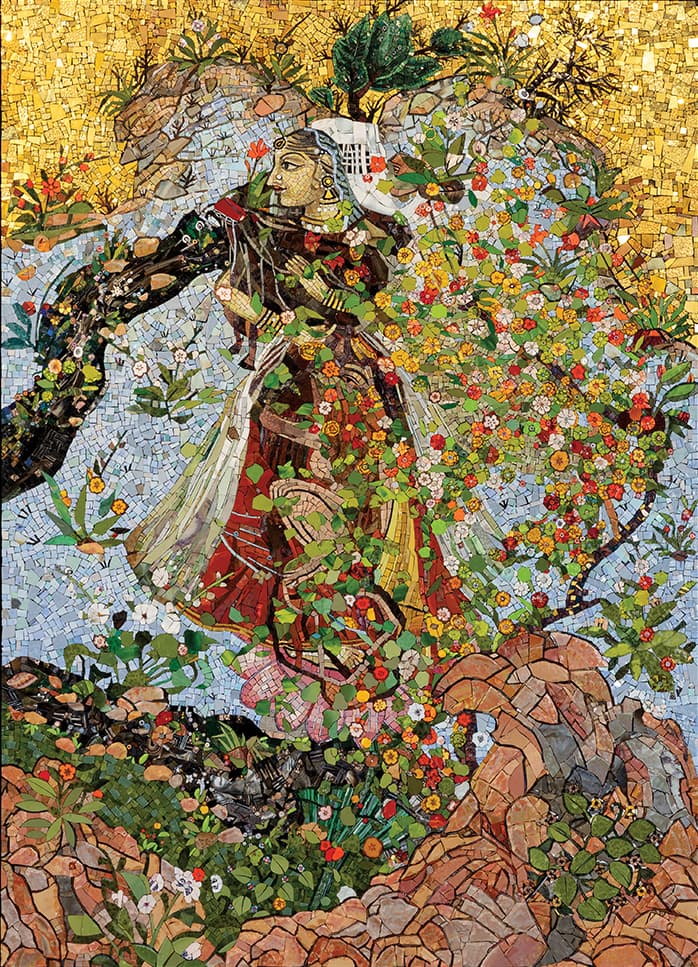Shahzia Sikander: Collective Behavior
- Magazine Article
- Exhibitions
The exhibition travels from Venice to Cleveland

Touchstone, 2021. Shahzia Sikander (Pakistani American, b. 1969). Glass mosaic with patinated brass frame; 211.1 x 152.1 cm. Collection of Kenneth J. Birdwell. © Shahzia Sikander, courtesy of the artist and Sean Kelly, New York / Los Angeles
This past April, Shahzia Sikander: Collective Behavior opened at the Palazzo Soranzo van Axel in Venice. Co-organized by the Cleveland Museum of Art (CMA) and the Cincinnati Art Museum (CAM), this survey of the renowned Pakistani American artist was a Collateral Event of the 60th International Art Exhibition—La Biennale di Venezia. During Collective Behavior’s six-month presentation in Venice, more than 65,000 international visitors came to see the show. Now, the CMA and CAM are thrilled to bring two complementary iterations of Collective Behavior home to Ohio. These exhibitions are on view at the same time, both opening on February 14, 2025.
For more than three decades, Shahzia Sikander (born 1969, Pakistan) has been animating South Asian visual histories through a contemporary perspective. Her work reimagines the past for our present moment, proposing new narratives that cross time and place. Working in a variety of media—paintings, drawings, prints, digital animations, mosaics, sculpture, and glass—Sikander considers Western relations with the global south and the wider Islamic world, often through the lenses of gender and body politics. Her work is rooted in a lexicon of recurring motifs that makes visible marginalized subjects. At times turning the lens inward, Sikander reflects on her own experience as an immigrant and diasporic artist working in the United States.
In the Julia and Larry Pollock Focus Gallery, the CMA presents Sikander’s art, spanning time and medium, in relation to historical South Asian works from this museum’s collection that inspire her. The exhibition comprises a series of conversations between the present and the past that illuminate Sikander’s primary ideas and inquiries. The CMA’s version of Collective Behavior offers a narrative that the museum is uniquely suited to share: It carries forward in time the rich histories encompassed in the museum’s renowned South Asian collection and simultaneously situates contemporary artistic practice in relation to the global history that precedes it. Nearby in Cincinnati, CAM offers a comprehensive midcareer survey of Sikander’s work. Together, these three presentations—in Venice, Cleveland, and Cincinnati—offer a range of entry points into this important artist’s work.
In Cleveland, Sikander’s mosaic Touchstone (2021) is in conversation with three paintings from the 1500s and 1600s in the CMA’s Indian collection. Touchstone’s central figure is based on Radha, a Hindu goddess, who has historically been depicted as Krishna’s preferred lover. In Sikander’s representation, however, Radha is shown independent of Krishna, her own divine status and multifaceted identity made visible. Touchstone’s figure holds a chalawa (Punjabi for a shape-shifting ghost). As Sikander explains, the chalawa is “somebody who is so swift and transient, you can’t pin down who they are. I am identifying with the chalawa, resisting the routinely confronted categories: ‘Are you Muslim, Pakistani, artist, painter, Asian, Asian American, or what?’”

In Nur Jahan holding a portrait of Emperor Jahangir (c. 1627), the painting’s eponymous female protagonist similarly assumes agency in the work’s narrative. Identified as the favorite wife of Mughal emperor Jahangir (reigned 1605–27), Nur Jahan holds a formal portrait of her recently deceased husband. She handled most of the affairs of state and had hoped to remain in power after Jahangir’s death. However, she lost the throne to her stepson. Like the ghost in Sikander’s Touchstone, imperial power slips away. Upon studying this historical Indian work, Sikander noted a disparity between the physical presence and strength of Nur Jahan and the diminished stature of Jahangir, who is reduced to an image.

In 2024, Sikander created one of the most recent works in the show, Ode to Venice (2024), while she was developing Collective Behavior’s debut presentation. The work depicts a woman-led regatta arriving along the Venetian canals. Its composition and imagery are inspired by two Indian paintings from the 1700s in the collections of the CMA and CAM, respectively. On the occasion of Collective Behavior’s presentation in Cleveland, the three works are displayed together, emphasizing this unique collaborative project.
All three iterations of Collective Behavior are documented in a richly illustrated catalogue featuring scholarly and poetic responses to Sikander’s work.